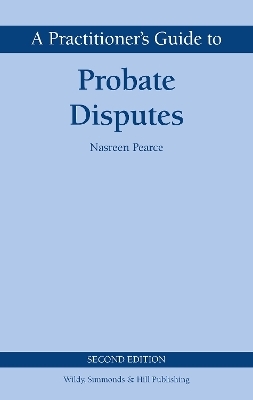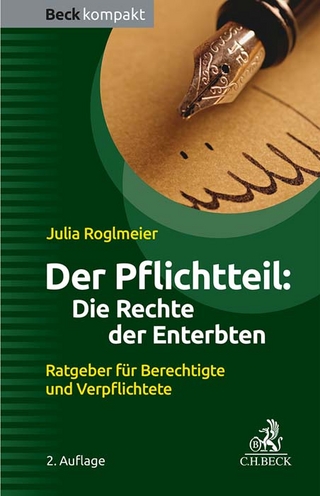
A Practitioner's Guide to Probate Disputes
Wildy, Simmonds and Hill Publishing (Verlag)
978-0-85490-290-3 (ISBN)
This second edition details the issues that personal representatives must deal with, including grounds for their removal and replacement; lifetime testamentary dispositions and claims; the challenges that can be made in relation to them, and the new measures introduced in relation to the execution and attestation of a will as a result of the COVID-19 pandemic. It also specifically covers wills procured as a result of fraud.
This book supplies guidance as to best practice and sets out examples from recent case law to illustrate the legal requirements and the problems which can arise from poor will drafting and a failure to investigate sufficiently all the circumstances relating to the testator/testatrix and their capacity to make a will. New chapters are included on burial disputes and personal representatives. The chapter on procedure for making applications has been expanded to include pre-action steps and disclosure generally. A comprehensive commentary on liability for costs has also been added.
Nasreen Pearce is a retired circuit judge and was formerly a district judge of the Principal Registry of the Family division. She is the General Editor of Butterworths Wills, Probate and Administration and has written extensively on family law and applications in the Court of Protection She is the author of A Practitioner's Guide to Inheritance Act Claims, 3rd edition, also published by Wildy, Simmonds & Hill.
Table of Cases
Table of Statutes
Table of Statutory Instruments
Table of Conventions
1INTRODUCTION
1.1Wills and codicils
1.2Formalities relating to wills
1.3Grounds for challenge
1.4Other testamentary dispositions
1.5Statutory right to challenge
1.6International wills
1.7Prospective reforms
2FORM, CONTENT AND INTERPRETATION OF A WILL
2.1Introduction
2.2Nature and form of a will
2.3Electronic wills
2.4Uncertainty relating to intention, subject matter or donee
2.5Examples of cases of construction of wills
2.6Wills where there is a foreign element
2.7Requirements of international wills
3EXECUTION OF A WILL
3.1Formal requirements
3.2Will must be in writing
3.3Will must be signed by the testator/testatrix or by some other person at his/her direction
3.4Position of the signature
3.5Execution of the wrong will
3.6Signing or acknowledgement of signature in the presence of witnesses
3.7Electronic signature
3.8Attestation in the presence of witnesses
3.9Execution and attestation of a will during the Covid-19 pandemic
3.10Evidence of attestation
3.11Competence of witnesses
4TESTAMENTARY CAPACITY
4.1Introduction
4.2Test of testamentary capacity under common law
4.3Ascertaining testamentary capacity – the Golden Rule
4.4At what stage is assessment of capacity relevant?
4.5Mental Capacity Act 2005 and the test for capacity under common law
4.6Delusions
4.7Senility, confusion and lucid intervals
4.8Drunkenness
4.9Language and literacy
4.10Medical evidence and its limitations
4.11Evidence and standard of proof
4.12Conclusion
5KNOWLEDGE AND APPROVAL
5.1Introduction
5.2Mistake
5.3Disability
5.4Lack of testamentary capacity
5.5Suspicious circumstances
5.6Standard and burden of proof
5.7Conclusion
6UNDUE INFLUENCE
6.1Introduction
6.2What constitutes undue influence?
6.3Confidential/fiduciary relationship
6.4Nature of the undue influence
6.5Fraud
6.6Burden of proof
6.7Standard of proof
6.8Evidence
6.9Procedure
7FORGERY
7.1Introduction
7.2Evidence
7.3Interface between civil action and forgery as a criminal offence
7.4 Fraud
7.5Burden and standard of proof
7.6Conclusion
8REVOCATION OF A WILL
8.1Introduction
8.2Revocation by marriage
8.3Revocation by marriage between same sex couples
8.4Revocation by formation of civil partnership
8.5Effect of conversion of civil partnership to same sex marriage
8.6Revocation by annulment or dissolution of the testator’s/testatrix’s marriage
8.7Revocation by annulment or dissolution of the testator’s/testatrix’s civil partnership
8.8Revocation and execution of a subsequent will
8.9Application for the admission to proof of a copy will or codicil where original is missing
8.10Revocation by destruction
8.11Conditional revocation
8.12Preparation and evidence
9RECTIFICATION
9.1Introduction
9.2Sections 20 and 21 of the Administration of Justice Act 1982
9.3Clerical error
9.4Failure to understand the testator’s/testatrix’s instructions
9.5Limitation period
9.6Burden and standard of proof
9.7Procedure
9.8Summary
10BURIAL DISPUTES
10.1Introduction
10.2Ownership of the body
10.3Exceptions to the rule on testator/testatrix direction over body
10.4Persons who have responsibilities for the body and funeral arrangements
10.5Impact of the European Convention on Human Rights
10.6Procedure
11LIFETIME AGREEMENTS AND GIFTS
11.1Introduction
11.2Contracts to leave property by will
11.3Proprietary estoppel
11.4Mutual wills
11.5Donatio mortis causa
11.6Conclusion
12JOINTLY OWNED ASSETS AND ASSETS HELD ON CONSTRUCTIVE TRUST
12.1Jointly owned assets
12.2Constructive trust
12.3Conclusion
13CLAIMS UNDER THE INHERITANCE (PROVISION FOR FAMILY AND DEPENDANTS) ACT 1975
13.1Introduction
13.2Who may apply?
13.3Time limit for making the claim
13.4Grounds for making a claim for financial provision under the Inheritance (Provision for Family and Dependants) Act 1975
13.5Matters which the court must take into account
13.6Powers of the court to make orders
13.7Property treated as part of the net estate and available for financial provision
13.8Conclusion
14CLAIMS AGAINST, AND REMOVAL OF, PERSONAL REPRESENTATIVES
14.1Introduction
14.2Breach of duties as personal representative
14.3Who can bring a claim?
14.4Burden and standard of proof
14.5What steps can a personal representative take to avoid personal liability?
14.6Application for a Beddoe order: direction and sanction of court to pursue or defend proceedings
14.7A Benjamin order
14.8Removal of personal representatives
14.9Grounds for removal
14.10Who can apply to remove a personal representative?
14.11Factors which may be relevant
14.12Procedure
15PROCEDURE
15.1Introduction
15.2Part 1 of the Civil Procedure Rules – ‘the overriding objective’
15.3Venue
15.4First step to take – enter a caveat (objection)
15.5Probate claims
15.6Parties
15.7How to start a probate claim
15.8What the court office must do
15.9Service
15.10Acknowledgement of service and defence
15.11Documents to be served with acknowledgement of service
15.12Counterclaim
15.13Contents of defence/counterclaim
15.14Failure to acknowledge service or file a defence
15.15Discontinuance or dismissal of a claim
15.16Extension of time limits
15.17Disclosure under Part 31 of the Civil Procedure Rules
15.18 Obtaining further information under Part 18 of the Civil Procedure Rules
15.19Inspection of testamentary documents
15.20Rectification of wills
15.21Costs
15.22Conclusion
16STATUTORY WILLS
16.1Introduction
16.2Court’s statutory powers to make a statutory will
16.3Best interests
16.4Pre-action preparation
16.5Procedure
16.6Effect of execution
16.7Conclusion
APPENDICES
ASTATUTORY MATERIAL
A1Wills Act 1837
A2Administration of Justice Act 1982 (extracts)
BPRECEDENTS
B1Non-Contentious Probate Rules 1987 (SI 1987/2024) –
First Schedule, Form 3 Caveat
B2Non-Contentious Probate Rules 1987 (SI 1987/2024) –
First Schedule, Form 4 Warning to Caveator
B3Non-Contentious Probate Rules 1987 (SI 1987/2024) –
First Schedule, Form 5 Appearance to Warning or Citation
B4Affidavit of Service of Warning and of Non-receipt of Summons for Directions
B5Witness Statement/Affidavit about Testamentary Documents
B6Some Examples of Undue Influence to be Set Out in the Particulars of Claim
B7Defence Limited to Putting the Personal Representative to Proof of the Will
B8Defence Alleging Want of Due Execution: Lack of Testamentary Capacity
CPRACTICE GUIDANCE
C1ACTAPS Practice Guidance for the Resolution of Probate and Trust Disputes (ACTAPS Code)
| Erscheinungsdatum | 11.04.2022 |
|---|---|
| Reihe/Serie | Wildy Practitioner Guide Series |
| Verlagsort | London |
| Sprache | englisch |
| Maße | 152 x 229 mm |
| Gewicht | 630 g |
| Themenwelt | Recht / Steuern ► EU / Internationales Recht |
| Recht / Steuern ► Privatrecht / Bürgerliches Recht ► Besonderes Schuldrecht | |
| Recht / Steuern ► Privatrecht / Bürgerliches Recht ► Zivilverfahrensrecht | |
| ISBN-10 | 0-85490-290-2 / 0854902902 |
| ISBN-13 | 978-0-85490-290-3 / 9780854902903 |
| Zustand | Neuware |
| Informationen gemäß Produktsicherheitsverordnung (GPSR) | |
| Haben Sie eine Frage zum Produkt? |
aus dem Bereich


